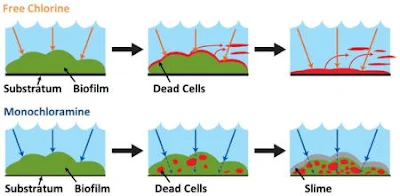Correlating Penetration with Biofilm Activity and Viability
Disinfectant biofilm penetration and its effect on biofilm aerobic activity and viability are still unclear. In this study, free chlorine and monochloramine were applied until full biofilm penetration occurred, and their effects on biofilm aerobic activity and viability were investigated in three–dimensions throughout the entire biofilm depth, extending previous work where viability analysis was limited to the upper biofilm (50 μm depth), free chlorine penetration did not reach completion, and only one–dimensional (depth) profiles were obtained. The free chlorine and monochloramine biofilm concentration profiles were correlated spatially and temporally with aerobic microbial activity and cell–membrane integrity based viability using a combination of (1) microelectrode measurements for disinfectant penetration and (2) Live/Dead BacLight staining, cryo–cross–sectioning, and confocal micrographs analysis for viability measurements throughout the entire biofilm depth. Compared to monochloramine, free chlorine penetration (1) was slower, (2) led to a greater decrease in biofilm thickness from sloughing, and (3) corresponded directly with a viability decrease. In addition, biofilm heterogeneity led to minor differences in either disinfectant’s biofilm penetration, and prior biofilm exposure to monochloramine provided little impact to subsequent free chlorine biofilm penetration.
REFERENCE:
Lee WH, Pressman JG, Wahman DG. Three-Dimensional Free Chlorine and Monochloramine Biofilm Penetration: Correlating Penetration with Biofilm Activity and Viability. Environ Sci Technol. 2018;52(4):1889–1898. doi:10.1021/acs.est.7b05215
-----------------------------------------------------------
Sigue este Blog en Facebook y Twitter
-----------------------------------------------------------
REFERENCE:
Lee WH, Pressman JG, Wahman DG. Three-Dimensional Free Chlorine and Monochloramine Biofilm Penetration: Correlating Penetration with Biofilm Activity and Viability. Environ Sci Technol. 2018;52(4):1889–1898. doi:10.1021/acs.est.7b05215
-----------------------------------------------------------
Sigue este Blog en Facebook y Twitter
-----------------------------------------------------------




Comentarios